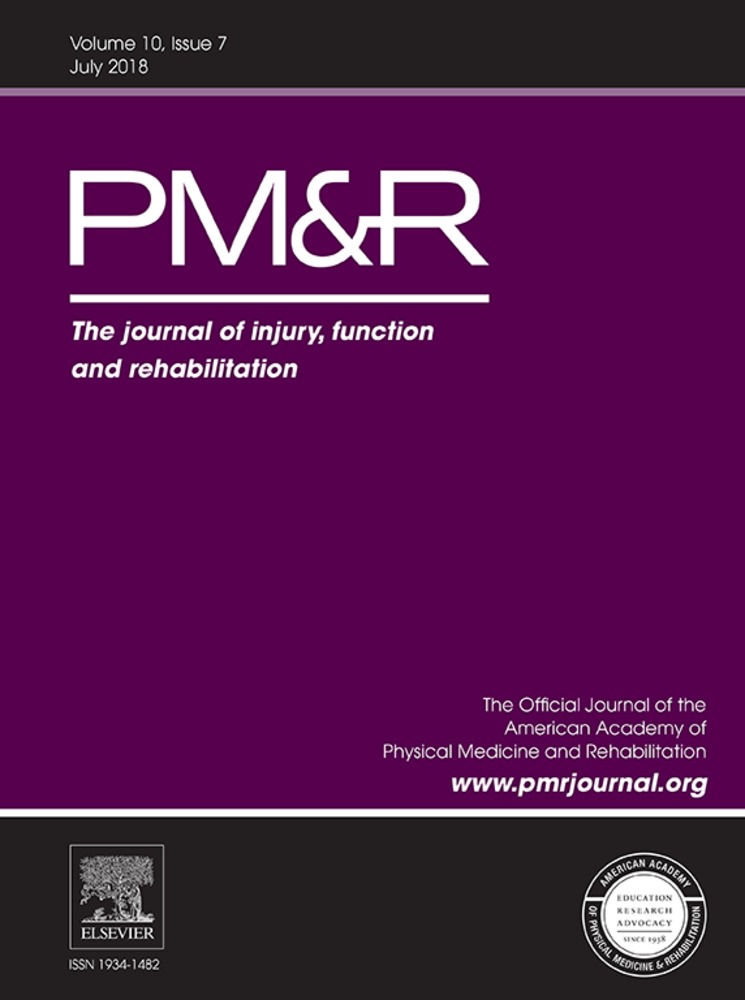Challenging Diagnosis and Inpatient Rehabilitation of Acute Bilateral Neuralgic Amyotrophy Possibly Attributed to Lyme Disease: A Case Report
Corresponding Author
Shangming Zhang MD
Department of Physical Medicine and Rehabilitation, Penn State Hershey Rehabilitation Hospital, Penn State Hershey Medical Center, Hershey, PA 17033
Department of Neurology, Cleveland Clinic Foundation, Cleveland, OH
Department of Physical Medicine and Rehabilitation, Penn State Hershey Rehabilitation Hospital, Penn State Hershey Medical Center, Hershey, PA
Disclosure: nothing to disclose
Address correspondence to: S.Z.Search for more papers by this authorLucy Q. Zhang MD
Department of Physical Medicine and Rehabilitation, Penn State Hershey Rehabilitation Hospital, Penn State Hershey Medical Center, Hershey, PA 17033
Department of Neurology, Cleveland Clinic Foundation, Cleveland, OH
Department of Physical Medicine and Rehabilitation, Penn State Hershey Rehabilitation Hospital, Penn State Hershey Medical Center, Hershey, PA
Disclosure: nothing to disclose
Search for more papers by this authorMegan Wright PA-C
Department of Physical Medicine and Rehabilitation, Penn State Hershey Rehabilitation Hospital, Penn State Hershey Medical Center, Hershey, PA 17033
Department of Neurology, Cleveland Clinic Foundation, Cleveland, OH
Department of Physical Medicine and Rehabilitation, Penn State Hershey Rehabilitation Hospital, Penn State Hershey Medical Center, Hershey, PA
Disclosure: nothing to disclose
Search for more papers by this authorDavid R. Gater MD, PhD
Department of Physical Medicine and Rehabilitation, Penn State Hershey Rehabilitation Hospital, Penn State Hershey Medical Center, Hershey, PA 17033
Department of Neurology, Cleveland Clinic Foundation, Cleveland, OH
Department of Physical Medicine and Rehabilitation, Penn State Hershey Rehabilitation Hospital, Penn State Hershey Medical Center, Hershey, PA
Disclosure: nothing to disclose
Search for more papers by this authorCorresponding Author
Shangming Zhang MD
Department of Physical Medicine and Rehabilitation, Penn State Hershey Rehabilitation Hospital, Penn State Hershey Medical Center, Hershey, PA 17033
Department of Neurology, Cleveland Clinic Foundation, Cleveland, OH
Department of Physical Medicine and Rehabilitation, Penn State Hershey Rehabilitation Hospital, Penn State Hershey Medical Center, Hershey, PA
Disclosure: nothing to disclose
Address correspondence to: S.Z.Search for more papers by this authorLucy Q. Zhang MD
Department of Physical Medicine and Rehabilitation, Penn State Hershey Rehabilitation Hospital, Penn State Hershey Medical Center, Hershey, PA 17033
Department of Neurology, Cleveland Clinic Foundation, Cleveland, OH
Department of Physical Medicine and Rehabilitation, Penn State Hershey Rehabilitation Hospital, Penn State Hershey Medical Center, Hershey, PA
Disclosure: nothing to disclose
Search for more papers by this authorMegan Wright PA-C
Department of Physical Medicine and Rehabilitation, Penn State Hershey Rehabilitation Hospital, Penn State Hershey Medical Center, Hershey, PA 17033
Department of Neurology, Cleveland Clinic Foundation, Cleveland, OH
Department of Physical Medicine and Rehabilitation, Penn State Hershey Rehabilitation Hospital, Penn State Hershey Medical Center, Hershey, PA
Disclosure: nothing to disclose
Search for more papers by this authorDavid R. Gater MD, PhD
Department of Physical Medicine and Rehabilitation, Penn State Hershey Rehabilitation Hospital, Penn State Hershey Medical Center, Hershey, PA 17033
Department of Neurology, Cleveland Clinic Foundation, Cleveland, OH
Department of Physical Medicine and Rehabilitation, Penn State Hershey Rehabilitation Hospital, Penn State Hershey Medical Center, Hershey, PA
Disclosure: nothing to disclose
Search for more papers by this authorAbstract
Neuralgic amyotrophy (NA) is a neurologic syndrome of unknown etiology primarily affecting the brachial plexus. We are reporting an unusual case of acute bilateral NA that was possibly secondary to Lyme disease. The patient demonstrated significant functional gains and was discharged home after 2 weeks of inpatient rehabilitation, supporting the role of inpatient rehabilitation in acute NA. In this report, we discuss the diagnosis, electrodiagnostic progression, pain management, goals for inpatient rehabilitation, and overall prognosis of NA.
Level of Evidence
V
References
- 1N. van Alfen, B.G. van Engelen. The clinical spectrum of neuralgic amyotrophy in 246 cases. Brain. 2006; 129: 438–450.
- 2N. van Alfen. Clinical and pathophysiological concepts of neuralgic amyotrophy. Nat Rev Neurol. 2011; 7: 315–322.
- 3M.P. te Lintelo, P.J. Koehler, T.H. van Diepen, R. Beekman. Neuroborreliosis mimicking brachial amyotrophic diplegia. Clin Neurol Neurosurg. 2012; 114: 159–160.
- 4D. Wendling, P. Sevrin, A. Bouchaud-Chabot, et al. Parsonage-Turner syndrome revealing Lyme borreliosis. Joint Bone Spine. 2009; 76: 202–204.
- 5F.P. Tjoumakaris, O.A. Anakwenze, V. Kancherla, N. Pulos. Neuralgic amyotrophy (Parsonage-Turner syndrome). J Am Acad Orthop Surg. 2012; 20: 443–449.
- 6E.H. Cup, J. Ijspeert, R.J. Janssen, et al. Residual complaints after neuralgic amyotrophy. Arch Phys Med Rehabil. 2013; 94: 67–73.
- 7L. Dillin, F.T. Hoaglund, M. Scheck. Brachial neuritis. J Bone Joint Surg Am. 1985; 67: 878–880.
- 8E.C. McCarty, P. Tsairis, R.F. Warren. Brachial neuritis. Clin Orthop Relat Res. 1999; (368): 37–43.
- 9C.A. Helms, S. Martinez, K.P. Speer. Acute brachial neuritis (Parsonage-Turner syndrome): MR imaging appearance—report of three cases. Radiology. 1998; 207: 255–259.
- 10I. Duman, I. Guvenc, T.A. Kalyon. Neuralgic amyotrophy, diagnosed with magnetic resonance neurography in acute stage: A case report and review of the literature. Neurologist. 2007; 13: 219–221.
- 11Z. ArAnyi, A. Csillik, K. DeVay, et al. Ultrasonography in neuralgic amyotrophy: Sensitivity, spectrum of findings, and clinical correlations. Muscle Nerve. 2017; 56: 1054–1062.
- 12M.A. Ferrante, A.J. Wilbourn. Lesion distribution among 281 patients with sporadic neuralgic amyotrophy. Muscle Nerve. 2017; 55: 858–861.
- 13C.M. Gaskin, C.A. Helms. Parsonage-Turner syndrome: MR imaging findings and clinical information of 27 patients. Radiology. 2006; 240: 501–507.
- 14C.C. Smith, A.C. Bevelaqua. Challenging pain syndromes: Parsonage-Turner syndrome. Phys Med Rehabil Clin N Am. 2014; 25: 265–277.
- 15N. van Alfen, S.P. van der Werf, B.G. van Engelen. Long-term pain, fatigue, and impairment in neuralgic amyotrophy. Arch Phys Med Rehabil. 2009; 90: 435–439.
- 16J.J. Van Eijk, J.T. Groothuis, N. Van Alfen. Neuralgic amyotrophy: An update on diagnosis, pathophysiology, and treatment. Muscle Nerve. 2016; 53: 337–350.
- 17J. Ijspeert, R.M. Janssen, A. Murgia, et al. Efficacy of a combined physical and occupational therapy intervention in patients with subacute neuralgic amyotrophy: A pilot study. NeuroRehabilitation. 2013; 33: 657–665.
- 18P. Tsairis, P.J. Dyck, D.W. Mulder. Natural history of brachial plexus neuropathy. Report on 99 patients. Arch Neurol. 1972; 27: 109–117.
- 19G.W. Misamore, D.E. Lehman. Parsonage-Turner syndrome (acute brachial neuritis). J Bone Joint Surg Am. 1996; 78: 1405–1408.




